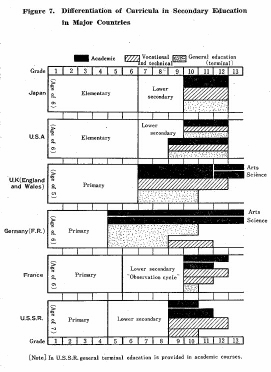| Home > Policy > White Paper, Notice, Announcement > White Paper > EDUCATIONAL STANDARDS IN JAPAN 1965 > CHAPTER |
||
It is a crucial problem to determine what types of streams should be provided in the school education and when division into these streams is to be made.
The types of streams
In Japan, the upper secondary school (Kotogakko) provides two major streams; the general and the vocational. Some schools provide for both streams, others for either of the two. The general stream offers two kinds of curriculum, the one placing equal emphasis on all the teaching subjects(Called Type A) and the other placing special emphasis on the following five teaching subjects (called Type B): Japanese language, Mathematics, Social studies, Science, and Foreign language. The first type of curriculum is intended to provide terminal education of a general nature, while the latter is the college preparatory curriculum.

In the U.S.A. it is general that the comprehensive high Schoo1 offers several programs or curriculums, the most commonly offered being the general, the college preparatory, and the vocational. In the European countries such as England & Wales, the Federal Republic of Germany and France, such curriculums are generally offered by different schools with different aims. In England and Wales, the college preparatory stream offered by the secondary grammar schools is further divided into two courses, science and arts at the 12th grade and upward, being commonly called the Sixth Form. In France, both the college preparatory and the vocational curriculums have longer and shorter courses, the longer leading to university education and the shorter to educational institutions other than universities, such as normal schools which aim at training elementary school teachers. The longer college preparatory course is further divided into the classic and the modern. In the U.S.S.R. there are three divisions, as follows: the full-time general-labor course offering both general and labor education; the general course providing for part-time and correspondence education; and the longer and the shorter vocational courses. The organization in the U.S.S.R. is different from that of Japan, the U.S.A. or the European countries in that students completing the part-time and correspondence education are treated more favorably in university admission than the other students.
The stage of division into streams
The stage or grade at which pupils are directed into different stream differs from one country to another. In the U.S.A., the U.S.S.R. and Japan, there is no division seen at the compulsory education stage, with the same programs of general nature for all pupils. In France, pupils may be finally directed into different streams after an observation period covering the first 4 years of secondary education, during which pupils are kept under observation and are guided toward the stream that seems best suited to their abilities and aptitudes. Although pupils are placed in different classes with different programs, they can be transfered from one class to another based on the results of the observation. (For more detailed description as regards the observation period, refer to item 8 of this chapter.) In the U.K. and the Federal Republic of Germany, the division is still made at grade 7(11 years of age) and 5(10 years of age) respectively.
| Back to Top | MEXT HOME |